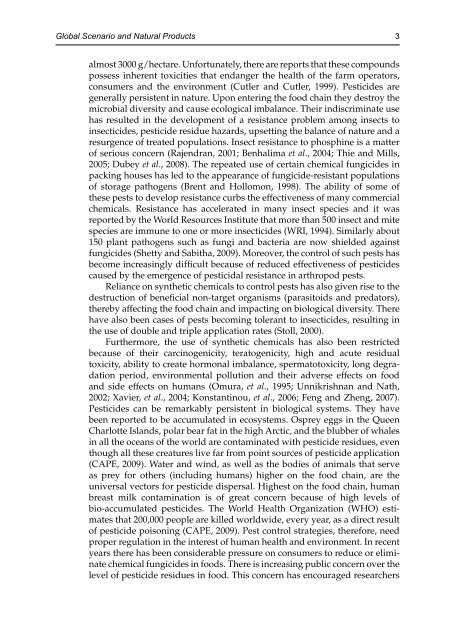natural-products-in-plant-pest-management
natural-products-in-plant-pest-management
natural-products-in-plant-pest-management
Create successful ePaper yourself
Turn your PDF publications into a flip-book with our unique Google optimized e-Paper software.
Global Scenario and Natural Products 3almost 3000 g/hectare. Unfortunately, there are reports that these compoundspossess <strong>in</strong>herent toxicities that endanger the health of the farm operators,consumers and the environment (Cutler and Cutler, 1999). Pesticides aregenerally persistent <strong>in</strong> nature. Upon enter<strong>in</strong>g the food cha<strong>in</strong> they destroy themicrobial diversity and cause ecological imbalance. Their <strong>in</strong>discrim<strong>in</strong>ate usehas resulted <strong>in</strong> the development of a resistance problem among <strong>in</strong>sects to<strong>in</strong>secticides, <strong>pest</strong>icide residue hazards, upsett<strong>in</strong>g the balance of nature and aresurgence of treated populations. Insect resistance to phosph<strong>in</strong>e is a matterof serious concern (Rajendran, 2001; Benhalima et al., 2004; Thie and Mills,2005; Dubey et al., 2008). The repeated use of certa<strong>in</strong> chemical fungicides <strong>in</strong>pack<strong>in</strong>g houses has led to the appearance of fungicide-resistant populationsof storage pathogens (Brent and Hollomon, 1998). The ability of some ofthese <strong>pest</strong>s to develop resistance curbs the effectiveness of many commercialchemicals. Resistance has accelerated <strong>in</strong> many <strong>in</strong>sect species and it wasreported by the World Resources Institute that more than 500 <strong>in</strong>sect and mitespecies are immune to one or more <strong>in</strong>secticides (WRI, 1994). Similarly about150 <strong>plant</strong> pathogens such as fungi and bacteria are now shielded aga<strong>in</strong>stfungicides (Shetty and Sabitha, 2009). Moreover, the control of such <strong>pest</strong>s hasbecome <strong>in</strong>creas<strong>in</strong>gly difficult because of reduced effectiveness of <strong>pest</strong>icidescaused by the emergence of <strong>pest</strong>icidal resistance <strong>in</strong> arthropod <strong>pest</strong>s.Reliance on synthetic chemicals to control <strong>pest</strong>s has also given rise to thedestruction of beneficial non-target organisms (parasitoids and predators),thereby affect<strong>in</strong>g the food cha<strong>in</strong> and impact<strong>in</strong>g on biological diversity. Therehave also been cases of <strong>pest</strong>s becom<strong>in</strong>g tolerant to <strong>in</strong>secticides, result<strong>in</strong>g <strong>in</strong>the use of double and triple application rates (Stoll, 2000).Furthermore, the use of synthetic chemicals has also been restrictedbecause of their carc<strong>in</strong>ogenicity, teratogenicity, high and acute residualtoxicity, ability to create hormonal imbalance, spermatotoxicity, long degradationperiod, environmental pollution and their adverse effects on foodand side effects on humans (Omura, et al., 1995; Unnikrishnan and Nath,2002; Xavier, et al., 2004; Konstant<strong>in</strong>ou, et al., 2006; Feng and Zheng, 2007).Pesticides can be remarkably persistent <strong>in</strong> biological systems. They havebeen reported to be accumulated <strong>in</strong> ecosystems. Osprey eggs <strong>in</strong> the QueenCharlotte Islands, polar bear fat <strong>in</strong> the high Arctic, and the blubber of whales<strong>in</strong> all the oceans of the world are contam<strong>in</strong>ated with <strong>pest</strong>icide residues, eventhough all these creatures live far from po<strong>in</strong>t sources of <strong>pest</strong>icide application(CAPE, 2009). Water and w<strong>in</strong>d, as well as the bodies of animals that serveas prey for others (<strong>in</strong>clud<strong>in</strong>g humans) higher on the food cha<strong>in</strong>, are theuniversal vectors for <strong>pest</strong>icide dispersal. Highest on the food cha<strong>in</strong>, humanbreast milk contam<strong>in</strong>ation is of great concern because of high levels ofbio-accumulated <strong>pest</strong>icides. The World Health Organization (WHO) estimatesthat 200,000 people are killed worldwide, every year, as a direct resultof <strong>pest</strong>icide poison<strong>in</strong>g (CAPE, 2009). Pest control strategies, therefore, needproper regulation <strong>in</strong> the <strong>in</strong>terest of human health and environment. In recentyears there has been considerable pressure on consumers to reduce or elim<strong>in</strong>atechemical fungicides <strong>in</strong> foods. There is <strong>in</strong>creas<strong>in</strong>g public concern over thelevel of <strong>pest</strong>icide residues <strong>in</strong> food. This concern has encouraged researchers


